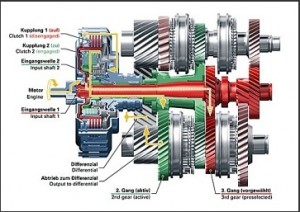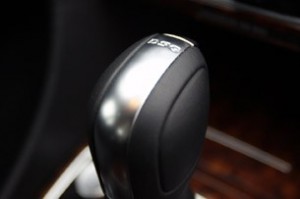 Depending on the year of manufacture, all Volkswagens with a manual transaxle have 1 of 2 types of clutch assembly:
Depending on the year of manufacture, all Volkswagens with a manual transaxle have 1 of 2 types of clutch assembly:
- 1972 and earlier — have a spring coil clutch, and single dry-plate
- 1973 and later — have a diaphragm spring clutch
The diaphragm spring clutch employs a splined hub that slide along the splines of the transaxle input shaft. The pressure plate and clutch maintain contact through pressure exerted by the coil springs in the diaphragm spring in the pressure plate.
With a cable release system that includes:
- Clutch Pedal
- Clutch Cable
- Clutch Release Lever
- Clutch Release Shaft
- Clutch Release Bearing
What Does the Clutch Do?
Depressing the clutch with your foot transmits the movement to the clutch release lever via the clutch cable. As the clutch lever turns, its forks press against the release bearing which slides on the input shaft toward the flywheel. On later model Volkswagen clutches, the pressure plate is lifted off the the clutch disc, disengaging it from the flywheel when the release bearing presses against the ‘fingers’ of the diaphragm spring. This series of actions releases the clutch from the spinning engine — allowing you to shift gears.
Most Common Problems With VW Clutches
Over time, the parts comprising the clutch assembly can wear. Routine inspection and maintenance and repair/replacement of clutch components can extend the life of your clutch assembly. The most common problems with Volkswagen clutches are:
problems with Volkswagen clutches are:
- Friction Material Wear — you will know when the friction material has worn on the disc if the clutch slips. Complete wear of the friction material will prohibit the clutch from transmitting any power to the wheels from the engine. By assuring that your car’s clutch disc and flywheel are spinning at the same speed, this problem can be virtually eliminated. If you ‘ride’ the clutch, the friction material will wear much faster!
- Worn Throwout (Clutch Release) Bearing — if you hear a rumbling sound when you engage the clutch, chances are your throwout bearing is worn.
It is possible to replace worn components, but to discover exactly where your problem lies, you can perform the following initial checks:
- Clutch Spin — with your VW in neutral, run the vehicle at normal idle speed with clutch pedal up. Depressing the clutch pedal, wait 5-7 seconds and shift into Reverse. If you hear any grinding noise, this likely indicates a problem with either the pressure plate or the clutch disc. Smooth operation generally means the pressure plate and clutch disc are fine.
- Clutch Release — with parking brake engaged (for safety reasons), run your VW’s engine an partially depress the clutch pedal (to within about 1/2-inch of the floor). Shift between 1st Gear and Reverse several times. If shifting is hard, or you hear grinding from the transaxle, this indicates a problem in the clutch release mechanism.
- Pivot Bushing — a visual inspection of the pivot bushing between the clutch pedal and the pedal shaft to assure the bushing is not binding or that is does not have excessive play. Replace as necessary.
- Clutch Cable — if you are having difficulties depressing the clutch pedal, the likely culprit is a faulty clutch cable. A visual inspection for kinks, frayed wires, rust or other signs of deterioration on a regular basis is recommended. After successful inspection, if the cable is in satisfactory condition, lubricate the cable with penetrating oil to provide a protective surface, extending the life of the cable. Try depressing the clutch pedal again — if it is still hard to push, further inspection is indicated.


Great service and great mechanics